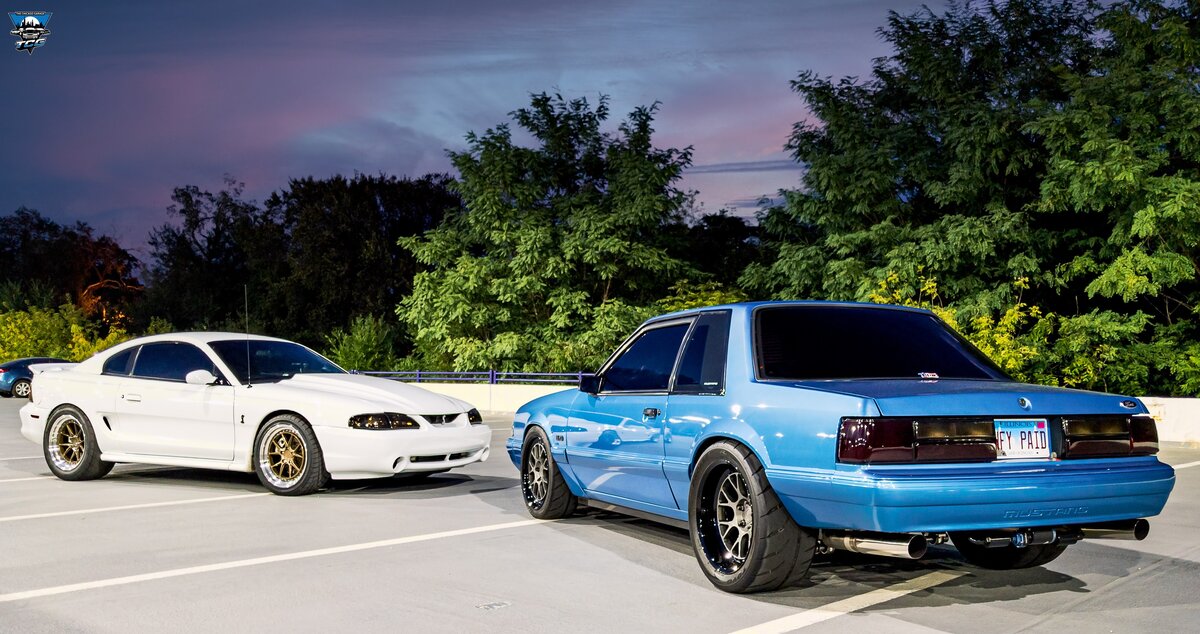A Brief History of the Ford Mustang - National Mustang Day - Part 2
Posted by MPU Admin on Apr 20th 2023

Mustang in the 1990s
After the 1980s, the Mustang continued to evolve and adapt to changing market demands. In 1994, the Mustang underwent its first major redesign since the 1979 model year. The new SN-95 platform featured a sleeker, more aerodynamic design, with a curvier body style and a more modern interior. The base model was powered by a 3.8-liter V6 engine that produced 145 horsepower, while the GT model came equipped with a 5.0-liter V8 that put out 215 horsepower.
The SN-95 platform received a number of updates over the next few years, including the introduction of a convertible model in 1995 and the addition of a new Cobra model in 1996. The Cobra was powered by a 4.6-liter V8 engine that produced 305 horsepower, making it the most powerful Mustang produced up to that point.
In 1999, the Mustang received another significant redesign with the introduction of the "New Edge" design language. This design language was characterized by sharper angles and more aggressive styling, with a distinctive nose and large wheel arches. The base model was powered by a 3.8-liter V6 engine that produced 190 horsepower, while the GT model came equipped with a 4.6-liter V8 that put out 260 horsepower.
The return of the Mustang Cobra also occurred during this time, with the 2003 Cobra model being dubbed the "Terminator" due to its powerful supercharged 4.6-liter V8 engine that produced 390 horsepower and 390 lb-ft of torque. This made the Terminator one of the most powerful Mustangs ever produced, and it quickly became a fan favorite.
In addition to the various special edition models, the Mustang also made a number of appearances in popular culture during the 1990s and early 2000s. It was featured prominently in the hit TV show "Beverly Hills 90210," and it played a major role in the 2000 movie "Gone in 60 Seconds," which starred Nicolas Cage and Angelina Jolie.
Overall, the 1990s and early 2000s marked a significant period of evolution for the Mustang, with multiple redesigns and the introduction of a number of special edition models that captured the hearts of Mustang enthusiasts around the world.
Mustang in the Modern Era (Early 2000s to Present Day)
The early 2000s marked a significant turning point for the Mustang. In 2005, Ford introduced the retro-inspired S-197 Mustang, which was based on the styling of the first-generation Mustangs. The S-197 platform featured a more refined suspension system and a more powerful engine lineup than the previous generation, making it one of the most capable Mustangs to date.
The S-197 Mustang was available in several trims, including the GT, GT500, and Bullitt. The GT featured a 4.6-liter V8 engine that produced 300 horsepower, while the GT500 featured a supercharged 5.4-liter V8 that produced 500 horsepower. The Bullitt, which was inspired by the 1968 Mustang driven by Steve McQueen in the movie "Bullitt," featured a 4.6-liter V8 that produced 315 horsepower.
In 2010, Ford introduced the fifth-generation Mustang, which was built on the S-197 platform but featured significant updates to its design and powertrain. The new Mustang featured an updated exterior design with a more aggressive front fascia and a revised rear end. The interior also received an update with higher-quality materials and improved ergonomics.
One of the most significant updates to the fifth-generation Mustang was the introduction of the Coyote powerplant. The Coyote engine, which debuted in the 2011 Mustang GT, featured a 5.0-liter V8 that produced 412 horsepower and 390 lb-ft of torque. The Coyote engine was praised for its power and responsiveness and quickly became a favorite among Mustang enthusiasts.
In 2015, Ford introduced the sixth-generation Mustang, which was built on the all-new S550 platform. The new platform featured significant updates to the Mustang's suspension and chassis, resulting in improved handling and ride quality. The exterior design was also updated, with a more aggressive front fascia and a sleeker profile.
The sixth-generation Mustang was available in several trims, including the EcoBoost, GT, and Shelby GT350. The EcoBoost featured a turbocharged 2.3-liter four-cylinder engine that produced 310 horsepower, while the GT featured the Coyote engine with an increased output of 435 horsepower. The Shelby GT350, which was introduced in 2016, featured a high-revving 5.2-liter V8 that produced 526 horsepower and 429 lb-ft of torque.
In the years following the release of the sixth-generation Mustang, Ford has continued to update and refine the platform. In 2018, the Mustang received a mid-cycle refresh, which included updates to the exterior design and a revised engine lineup. The GT received an updated version of the Coyote engine, which produced 460 horsepower and 420 lb-ft of torque. The EcoBoost also received an update, with its engine producing 310 horsepower and 350 lb-ft of torque.
In 2020, Ford introduced the Shelby GT500, which featured a supercharged 5.2-liter V8 that produced a whopping 760 horsepower and 625 lb-ft of torque. The GT500 was praised for its incredible performance and marked a new era for the Mustang as one of the most capable and powerful sports cars on the market.
The Mustang has come a long way since its debut in 1964, and its evolution over the years has been nothing short of impressive. From its early days as a simple, affordable sports car to its current status as a powerful and technologically advanced performance machine, the Mustang has remained a symbol of American automotive excellence.
Thank you for reading!
We will continue the historical journey in future articles that include the evolution of the Shelby Cobra models. Stay tuned!

